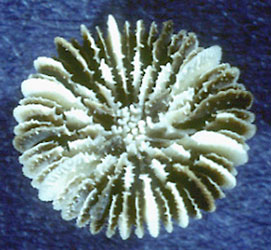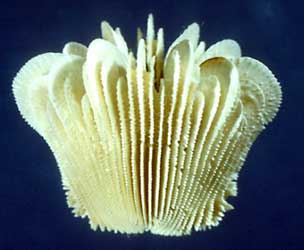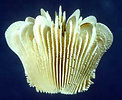Caryophyllioidea
Stephen D. Cairns- Caryophylliidae (non-monophyletic)
- Turbinoliidae
- Thecocyathidae

- Stenocyathidae
Introduction
Representatives of this family occur from the early Jurassic (about 180 million years ago) to the Recent, and are widespread in the world oceans, commonly being found as fossils on all continents, including Antarctica (Filkorn, 1994). One hundred sixteen genera have been described, most of which (73 genera and 347 species) occur in the Recent (Cairns et al., 1999). Most are azooxanthellate (86% of the genera) and solitary in growth form (63% of the genera). Although colonies may reach a meter or more in size, most caryophyllioideans are small, rarely greater than 20-30 mm in size. Although several genera in this superfamily are colonial reef builders, most are inconspicuous, occurring cryptically in shallow-water environments or as benthos on the lower shelf and upper slope (0-2165 m).
Characteristics
The superfamily is characterized by having coralla with a septothecal (constructed of thickening of septa) or parathecal (constructed of dissepiments) trabecular wall in the adult stage. Nontrabecular epitheca (rare) or textura (more common) may overlay the original wall, and granulated costae are usually present (Stolarski, 1995).
Discussion of Phylogenetic Relationships
No phylogenetic analysis has been done on the suprageneric taxa of the Caryophyllioidea; however, Stolarski (1995, 1996), Romano and Palumbi (1996), and Romano and Cairns (2000) are currently investigating and reassessing the higher level relationships in this superfamily by using characteristics of the corallum microstructure and DNA sequences, respectively.
References
Cairns S. D., B. W. Hoeksema, and J. van der Land. 1999. Appendix: List of Extant Stony Corals. Attol Research Bulletin, 459:13-46.
Filkorn, H. F. 1994. Fossil scleractinian corals from the James Ross Basin, Antarctica. Antarctic Research Series, 65: 96 pp.
Romano, S. L. and S. D. Cairns. 2000. Molecular Phylogenetic Hypotheses from the Evolution of Scleractinian Corals. Bulletin of Marine Science.
Romano, S. L. and S. R. Palumbi. 1996. Evolution of scleractinian corals inferred from molecular systematics. Science, 271: 640-642.
Stolarski, J. 1995. Ontogenetic development of the thecal structures in caryophylliine scleractinian corals. Acta Palaeontologica Polonica, 40: 19-44.
Stolarski, J. 1996. Gardineria -- a scleractinian living fossil. Acta Palaeontologica Polonica, 41: 339-367.
Stolarski, J. 2000. Origin and phylogeny of Guyniidae (Scleractinia) in the light of microstructural data. Lethaia, 33: 13-38.
Wells, J. W. 1956. Scleractinia. Pp. F328-F444 In: Moore, R. C. (editor) Treatise on Invertebrate Paleontology, Part F: Coelenterata. University of Kansas Press, Lawrence.
Title Illustrations

| Scientific Name | Deltocyathus calcar |
|---|---|
| Location | off St. Vincent, Lesser Antilles (depth 231 m) |
| Specimen Condition | Dead Specimen |
| Body Part | skeleton |
| View | Calicular view |
| Size | Diameter of corallum 11 mm |
| Image Use |
 This media file is licensed under the Creative Commons Attribution-NonCommercial License - Version 3.0. This media file is licensed under the Creative Commons Attribution-NonCommercial License - Version 3.0.
|
| Copyright |
© 2002
Stephen D. Cairns

|
| Scientific Name | Cyathotrochus pileus |
|---|---|
| Location | the Philippines (depth 494 m) |
| Comments | Note the deep intercostal grooves. |
| Specimen Condition | Dead Specimen |
| Body Part | skeleton |
| View | Side view |
| Size | Width of corallum 23 mm |
| Image Use |
 This media file is licensed under the Creative Commons Attribution-NonCommercial License - Version 3.0. This media file is licensed under the Creative Commons Attribution-NonCommercial License - Version 3.0.
|
| Copyright |
© 2002
Stephen D. Cairns

|
About This Page
Creation of this page was supported by US National Science Foundation grants DEB95-21819 and DEB 99-78106 (in the program PEET - Partnerships to Enhance Expertise in Taxonomy) to Daphne G. Fautin, grant DEB99-78086 (in the program PEET) to Stephen D. Cairns, and grant OCE 00-03970 (in NOPP, the National Oceanographic Partnership Program) to D.G.F. and Robert W. Buddemeier.Technical assistance was rendered by Adorian Ardelean.
Stephen D. Cairns

Smithsonian Institution, Washington, D. C., USA
Correspondence regarding this page should be directed to Stephen D. Cairns at
cairnss@si.edu
Page copyright © 2002 Stephen D. Cairns
 Page: Tree of Life
Caryophyllioidea .
Authored by
Stephen D. Cairns.
The TEXT of this page is licensed under the
Creative Commons Attribution-NonCommercial License - Version 3.0. Note that images and other media
featured on this page are each governed by their own license, and they may or may not be available
for reuse. Click on an image or a media link to access the media data window, which provides the
relevant licensing information. For the general terms and conditions of ToL material reuse and
redistribution, please see the Tree of Life Copyright
Policies.
Page: Tree of Life
Caryophyllioidea .
Authored by
Stephen D. Cairns.
The TEXT of this page is licensed under the
Creative Commons Attribution-NonCommercial License - Version 3.0. Note that images and other media
featured on this page are each governed by their own license, and they may or may not be available
for reuse. Click on an image or a media link to access the media data window, which provides the
relevant licensing information. For the general terms and conditions of ToL material reuse and
redistribution, please see the Tree of Life Copyright
Policies.
- First online 28 October 2002
Citing this page:
Cairns, Stephen D. 2002. Caryophyllioidea . Version 28 October 2002. http://tolweb.org/Caryophyllioidea/19019/2002.10.28 in The Tree of Life Web Project, http://tolweb.org/











 Go to quick links
Go to quick search
Go to navigation for this section of the ToL site
Go to detailed links for the ToL site
Go to quick links
Go to quick search
Go to navigation for this section of the ToL site
Go to detailed links for the ToL site